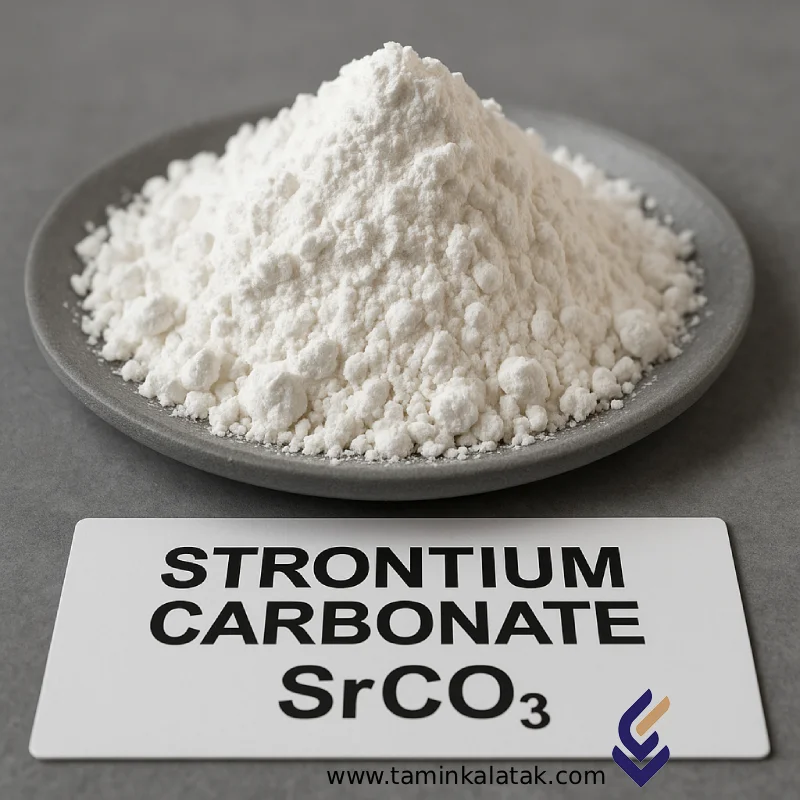Strontium carbonate
Strontium Carbonate (SrCO₃) is a white, odorless, crystalline inorganic compound naturally found in the mineral Strontianite. Known for its excellent thermal stability, chemical resistance, and optical properties, it plays a key role in glassmaking, ceramics, pyrotechnics, metallurgy, and electronics.
In the global chemicals market, Strontium Carbonate is considered one of the most important and widely used members of the carbonate family. Its unique combination of properties makes it difficult to replace in many industrial applications.
Chemical and Structural Information
-
Chemical Formula: SrCO₃
-
Ionic Composition: Strontium ion (Sr²⁺) and Carbonate ion (CO₃²⁻)
-
Crystal System: Orthorhombic
-
Bond Type: Strong ionic bonds providing high mechanical and thermal stability
-
Chemical Classification: Inorganic Carbonates
The orthorhombic crystalline structure of Strontium Carbonate imparts excellent structural integrity, making it suitable for high-temperature and electroceramic applications.
Physical and Chemical Properties
| Property | Value / Description |
|---|---|
| Appearance | White powder or granules |
| Molecular Weight | 147.63 g/mol |
| Density | ~3.7 g/cm³ |
| Solubility | Insoluble in water; soluble in dilute acids with CO₂ release |
| Thermal Stability | Stable at ambient temperature; decomposes at elevated heat |
These characteristics make Strontium Carbonate a preferred component in heat- and chemically-stable formulations, particularly for glass and ceramic industries.
Production Methods
Strontium Carbonate is produced through two main routes:
-
Natural Process: Extraction and purification from Strontianite mineral
-
Industrial Process: Reaction of Strontium Sulfide (SrS) with Carbon Dioxide (CO₂) or Sodium Carbonate (Na₂CO₃), forming SrCO₃ precipitate
The industrial route is most common for large-scale production due to its high yield and cost efficiency.
Applications
-
Glass Industry: Enhances transparency, reduces X-ray absorption, and improves thermal stability of specialty glass
-
Ceramics and Glazes: Improves mechanical strength, controls thermal expansion, and provides distinctive color tones
-
Pyrotechnics: Produces bright, stable red coloration in fireworks due to strontium ions
-
Electronics: Used in cathode ray tubes (CRT), electroceramics, and semiconductor materials
-
Metallurgy: Removes impurities such as sulfur and phosphorus in steelmaking and non-ferrous metal refining
-
Pigments and Coatings: Acts as a white pigment and enhances brightness and durability of coatings
Advantages
-
High chemical and thermal stability
-
Unique optical and color-forming properties
-
Excellent mechanical strength in ceramic and glass matrices
-
Widely applicable across advanced and high-performance industries
Limitations
-
Higher cost compared to alternatives such as Calcium Carbonate
-
Moderate toxicity if ingested or inhaled over prolonged periods
-
Requires strict safety and handling standards for industrial use
Environmental Impact
Strontium Carbonate is relatively low in environmental risk due to its poor solubility and chemical inertness. However, uncontrolled release of large quantities into soil or water may negatively impact aquatic ecosystems.
Therefore, proper waste management and recycling protocols are essential in large-scale industrial operations.
Alternatives and Substitutes
| Alternative | Application Notes |
|---|---|
| Calcium Carbonate (CaCO₃) | Cost-effective substitute in glass and ceramics with lower performance |
| Barium Carbonate (BaCO₃) | Used in certain ceramic applications but more toxic |
| Strontium Oxide (SrO) | Sometimes used as a reactive equivalent in specialty formulations |
Despite these alternatives, Strontium Carbonate remains irreplaceable in applications requiring specific optical and electronic characteristics.
Safety and Storage Guidelines
-
Storage: Keep in a cool, dry area, away from moisture and acids
-
Handling: Use protective gloves, safety goggles, and dust masks when handling powder
-
Transportation: Follow GHS and international chemical transport regulations
-
Emergency Measures: In case of skin or eye contact, rinse immediately with plenty of water
Summary
Strontium Carbonate (SrCO₃) is a versatile, high-performance inorganic compound essential in modern materials science and manufacturing. Its combination of optical brilliance, chemical stability, and industrial versatility makes it a key raw material in the glass, ceramic, and electronic sectors.
Applications
| Applications | , , , , |
|---|
Strontium carbonate
| Products | Chemical formula | CAS number | Grade | Vapor pressure | Physical appearance | Solubility in water | Melting point | Density (at 20°C) |
|---|---|---|---|---|---|---|---|---|
| Strontium carbonate | SrCO₃ | 02/05/1633 | Analytical grade، High purity، Technical grade | None (non-volatile solid) | White, odorless powder or crystals | Very low (about 0.0011 g/100 mL at 20°C) → practically insoluble | About 1494°C (decomposes before melting into SrO and CO₂) | 3.70 g/cm³ |







